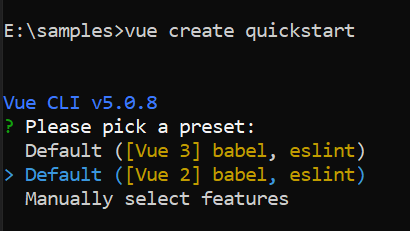Getting Started with the Vue Chat UI component in Vue 2
12 Sep 20256 minutes to read
This article provides a step-by-step guide for setting up a Vue 2 project using Vue-CLI and integrating the Syncfusion® Vue Chat UI component using the Composition API / Options API.
Prerequisites
System requirements for Syncfusion® Vue UI components
Setting up the Vue 2 project
To generate a Vue 2 project using Vue-CLI, use the vue create command. Follow these steps to install Vue CLI and create a new project:
npm install -g @vue/cli
vue create quickstart
cd quickstart
npm run serveor
yarn global add @vue/cli
vue create quickstart
cd quickstart
yarn run serveWhen creating a new project, choose the option Default ([Vue 2] babel, eslint) from the menu.

Once the quickstart project is set up with default settings, proceed to add Syncfusion® components to the project
Add Syncfusion® Vue packages
Syncfusion® packages are available at npmjs.com. To use Vue components, install the required npm package.
This article uses the Vue Chat UI component as an example. Install the @syncfusion/ej2-vue-interactive-chat package by running the following command:
npm install @syncfusion/ej2-vue-interactive-chat --saveor
yarn add @syncfusion/ej2-vue-interactive-chatImport Syncfusion® CSS styles
You can import themes for the Syncfusion® Vue component in various ways, such as using CSS or SASS styles from npm packages, CDN, CRG and Theme Studio. Refer to themes topic to know more about built-in themes and different ways to refer to themes in a Vue project.
In this article, the Material theme is applied using CSS styles, which are available in installed packages. The necessary Material CSS styles for the Chat UI component and its dependents were imported into the <style> section of src/App.vue file.
<style>
@import "../node_modules/@syncfusion/ej2-base/styles/material.css";
@import "../node_modules/@syncfusion/ej2-inputs/styles/material.css";
@import "../node_modules/@syncfusion/ej2-navigations/styles/material.css";
@import "../node_modules/@syncfusion/ej2-buttons/styles/material.css";
@import "../node_modules/@syncfusion/ej2-popups/styles/material.css";
@import '../node_modules/@syncfusion/ej2-dropdowns/styles/material.css';
@import "../node_modules/@syncfusion/ej2-interactive-chat/styles/material.css";
</style>Add Syncfusion® Vue component
Follow the below steps to add the Vue Chat UI component using Composition API or Options API:
1. First, import and register the Chat UI component in the script section of the src/App.vue file. If you are using the Composition API, you should add the setup attribute to the script tag to indicate that Vue will be using the Composition API.
<script setup>
import { ChatUIComponent as EjsChatui } from "@syncfusion/ej2-vue-interactive-chat";
</script><script>
import { ChatUIComponent } from "@syncfusion/ej2-vue-interactive-chat";
export default {
components: {
'ejs-chatui': ChatUIComponent
},
data () {
return {
}
}
}
</script>2. In the template section, define the Chat UI component.
<template>
<div id="app">
<div id='container' style="height: 400px; width: 400px;">
<ejs-chatui></ejs-chatui>
</div>
</div>
</template>Run the application
To run the application, use the following command:
npm run serveor
yarn run serveConfigure messages and user
You can use the <e-messages> tag directive to group all the messages and <e-message> tag to define each message and the user property to configure the current user for the chat.
<template>
<div id='container' style="height: 380px; width: 450px; margin: 0 auto;">
<ejs-chatui :user="currentUser">
<e-messages>
<e-message :author="currentUser" text="Hi Michale, are we on track for the deadline?"></e-message>
<e-message :author="michaleUser" text="Yes, the design phase is complete."></e-message>
<e-message :author="currentUser" text="I’ll review it and send feedback by today."></e-message>
</e-messages>
</ejs-chatui>
</div>
</template>
<script setup>
import { ChatUIComponent as EjsChatui, MessagesDirective as EMessages, MessageDirective as EMessage } from "@syncfusion/ej2-vue-interactive-chat";
const currentUser = {
id: "user1",
user: "Albert"
};
const michaleUser = {
id: "user2",
user: "Michale Suyama"
};
</script>
<style>
@import "../node_modules/@syncfusion/ej2-base/styles/material.css";
@import "../node_modules/@syncfusion/ej2-inputs/styles/material.css";
@import "../node_modules/@syncfusion/ej2-navigations/styles/material.css";
@import "../node_modules/@syncfusion/ej2-buttons/styles/material.css";
@import "../node_modules/@syncfusion/ej2-popups/styles/material.css";
@import "../node_modules/@syncfusion/ej2-interactive-chat/styles/material.css";
@import "../node_modules/@syncfusion/ej2-splitbuttons/styles/material.css";
</style><template>
<div id='container' style="height: 380px; width: 450px; margin: 0 auto;">
<ejs-chatui :user="currentUser">
<e-messages>
<e-message :author="currentUser" text="Hi Michale, are we on track for the deadline?"></e-message>
<e-message :author="michaleUser" text="Yes, the design phase is complete."></e-message>
<e-message :author="currentUser" text="I’ll review it and send feedback by today."></e-message>
</e-messages>
</ejs-chatui>
</div>
</template>
<script>
import { ChatUIComponent, MessagesDirective, MessageDirective } from "@syncfusion/ej2-vue-interactive-chat";
export default {
components: {
'ejs-chatui': ChatUIComponent,
'e-messages': MessagesDirective,
'e-message': MessageDirective
},
data() {
return {
currentUser: {
id: "user1",
user: "Albert",
},
michaleUser: {
id: "user2",
user: "Michale Suyama",
}
};
},
};
</script>
<style>
@import "../node_modules/@syncfusion/ej2-base/styles/material.css";
@import "../node_modules/@syncfusion/ej2-inputs/styles/material.css";
@import "../node_modules/@syncfusion/ej2-navigations/styles/material.css";
@import "../node_modules/@syncfusion/ej2-buttons/styles/material.css";
@import "../node_modules/@syncfusion/ej2-popups/styles/material.css";
@import "../node_modules/@syncfusion/ej2-interactive-chat/styles/material.css";
@import "../node_modules/@syncfusion/ej2-splitbuttons/styles/material.css";
</style>